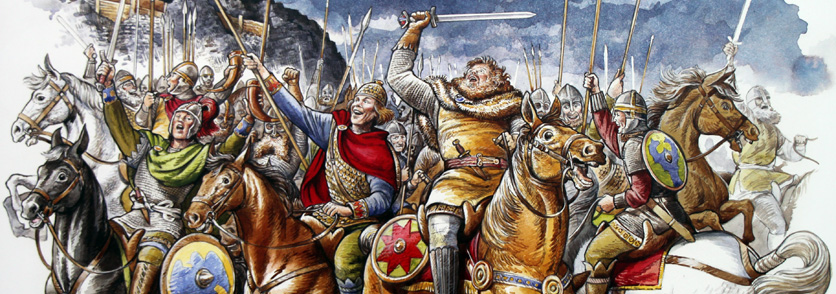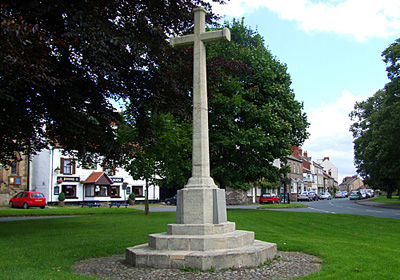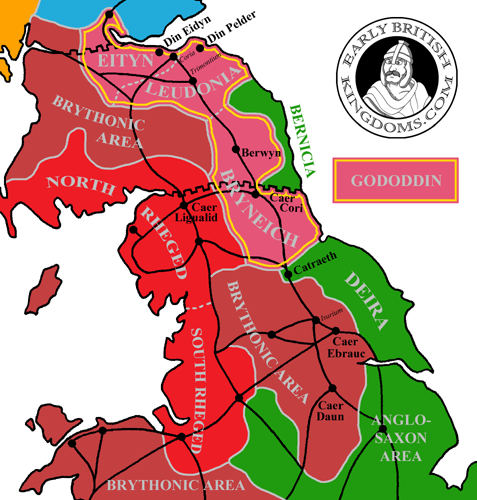|
|
|
THE BATTLE OF CATRAETH
Major
Attempt to keep the Celtic North connected

The
Battle of Catraeth has been long remembered in Welsh poetry, but the exact
details and circumstances surrounding this important event are not fully
recorded.
The Tradition:
The Battle of Catraeth is recorded in a poem called 'Y Gododdin' attributed
to the great Welsh bard, Aneirin. The title means 'The Gododdin[ians]'. The
poem survives in two 13th century versions, both slightly different, which are known as A
& B. Version B is the shorter, but older and perhaps more reliable
version. The language used
suggests it is a copy of a 9th century version of an early 7th century oral
original. Version A is purely 13th century in style and includes some details not
mentioned in Version B. The battle is generally accepted as an historical
battle that took place between 300 mounted British warriors of Gododdin (Lothian) and the
Anglians of Deira supposedly numbered between 50 & 100,000. The poem records that the Gododdin force included
warriors from across both what is now the North of England/Southern Scotland
and North Wales. The Deiran force appears to have included at least some
British warriors from Rheged and possibly also Anglian Bernicians. The Gododdin warriors were sent into battle by a certain Mynyddog Mwynfawr (the
Wealthy) who, for a
whole year, paid them for the task ahead by feasting with them at his palace
at Din Eityn (Edinburgh) - today the site of Edinburgh Castle. His three
generals leading the army were Cynon, Cynri and Cynrain. The battle was a
disastrous defeat for the British: either only one or three of them
survived.
 Battle
Site & Philology: The
battle site is not known for sure, but there is a general acceptance that it
is probably Catterick in North Yorkshire. This was first suggested by Thomas
Stephens in 1888 and has since been endorsed by the eminent historians, Sir Ifor Williams and
Kenneth Jackson. The identification, is not without problems, although these may not
be insurmountable. The Gododdin were "defending their land," but
had to cross "over their boundary" to do it. Philologically, there is no
objection to the development of Catraeth from Cataractonium which was the
name of the small Roman fort and associated 'vicus' or civilian settlement at
Catterick. There is considerable evidence for a continuance of occupation
into the early Sub-Roman period in the latter area: a very late Roman
apsidal building had occupational material build up into the 5th century and
was then replaced by wooden structures on a different alignment, while
similar buildings found elsewhere may be of the same date. However, it is
uncertain whether these could have lasted into the late 6th century.
Catterick was certainly in a strategic position, just south of
where Dere Street, running north from Caer Ebrauc (York), divided to head
for either Caer Cori (Corbridge) or Caer Ligualid (Carlisle). In the poetry
of Taliesin, Catraeth is said to have been ruled by King Urien of North
Rheged. It is clearly difficult to establish the exact political situation
in any part of late 6th century Britain, but in the central region of
Northern Britain, straddling the Pennines, it is especially unclear. A lot
of the time, the area may have been largely leaderless, with greater
monarchs from elsewhere claiming overlordship in regions traditionally
considered British, yet soon to become Anglian. Battle
Site & Philology: The
battle site is not known for sure, but there is a general acceptance that it
is probably Catterick in North Yorkshire. This was first suggested by Thomas
Stephens in 1888 and has since been endorsed by the eminent historians, Sir Ifor Williams and
Kenneth Jackson. The identification, is not without problems, although these may not
be insurmountable. The Gododdin were "defending their land," but
had to cross "over their boundary" to do it. Philologically, there is no
objection to the development of Catraeth from Cataractonium which was the
name of the small Roman fort and associated 'vicus' or civilian settlement at
Catterick. There is considerable evidence for a continuance of occupation
into the early Sub-Roman period in the latter area: a very late Roman
apsidal building had occupational material build up into the 5th century and
was then replaced by wooden structures on a different alignment, while
similar buildings found elsewhere may be of the same date. However, it is
uncertain whether these could have lasted into the late 6th century.
Catterick was certainly in a strategic position, just south of
where Dere Street, running north from Caer Ebrauc (York), divided to head
for either Caer Cori (Corbridge) or Caer Ligualid (Carlisle). In the poetry
of Taliesin, Catraeth is said to have been ruled by King Urien of North
Rheged. It is clearly difficult to establish the exact political situation
in any part of late 6th century Britain, but in the central region of
Northern Britain, straddling the Pennines, it is especially unclear. A lot
of the time, the area may have been largely leaderless, with greater
monarchs from elsewhere claiming overlordship in regions traditionally
considered British, yet soon to become Anglian.
 Possible
Interpretations: The Y
Gododdin poem has
been dated to around AD 600, while the events it describes probably happened
some time in the previous twenty years. If the battlefield was indeed at
Catterick, however, why this was so far from Gododdin itself requires some
explanation. The post-Roman kingdom of Gododdin is generally considered to
have been centred
around what we now call Lothian, probably with its 'capital' at Din Pelder (Traprain
Law near Haddington). The line of kings there is well recorded. It does not
include a Mynyddog. John T Kock theorises that Mynyddog Mwynfawr is merely a
personification of Din Eityn itself, as the host of the warrior band. The
Welsh mynyddog, meaning mountainous, would refer to Edinburgh Rock on which
stands the present castle. True, as a pedigree and not a king list, the line
of Gododdin would not record any sibling monarchs, but it is likely that the
King of Gododdin at this time was a man named Cathen ap Cawrdaf.
Furthermore, the Catraeth general, Cynon, was the son of Clydno Eityn, a
prince of adjoining Strathclyde whose epithet would suggest that it was he
and his son who ruled the area around Din Eityn (Edinburgh), not Mynyddog.
Perhaps it was a sub-kingdom of Gododdin. In fact, the heart of Gododdin was,
at this time, probably already called Leudonia, after its late 5th century king,
Lleuddun
Luyddog (alias King Lot of Arthurian legend). This is from whence the name
Lothian comes. The name 'Gododdin' seems to
have referred to a somewhat larger area. This makes perfect sense when one
remembers that its people (and its name) stem from the Iron Age tribe of the
Votodini, whose territory spread from the head of the Firth of Forth
all the way down what's now the Northumberland and Durham coast. So the
people of the kingdom of Bryneich, though ruled by a Coelling, would have
been considered part of 'the Gododdin'. The Lothian kings may even have
thought of themselves as overkings there. With Bernician Anglians already
expanding their control within the kingdom, naturally, the Goododdin would
want to protect the main communication links with their fellow Britons
further south. If the major junction just beyond the Bryneich border had
been taken by the Deirans, this would require a reactive strike. Possible
Interpretations: The Y
Gododdin poem has
been dated to around AD 600, while the events it describes probably happened
some time in the previous twenty years. If the battlefield was indeed at
Catterick, however, why this was so far from Gododdin itself requires some
explanation. The post-Roman kingdom of Gododdin is generally considered to
have been centred
around what we now call Lothian, probably with its 'capital' at Din Pelder (Traprain
Law near Haddington). The line of kings there is well recorded. It does not
include a Mynyddog. John T Kock theorises that Mynyddog Mwynfawr is merely a
personification of Din Eityn itself, as the host of the warrior band. The
Welsh mynyddog, meaning mountainous, would refer to Edinburgh Rock on which
stands the present castle. True, as a pedigree and not a king list, the line
of Gododdin would not record any sibling monarchs, but it is likely that the
King of Gododdin at this time was a man named Cathen ap Cawrdaf.
Furthermore, the Catraeth general, Cynon, was the son of Clydno Eityn, a
prince of adjoining Strathclyde whose epithet would suggest that it was he
and his son who ruled the area around Din Eityn (Edinburgh), not Mynyddog.
Perhaps it was a sub-kingdom of Gododdin. In fact, the heart of Gododdin was,
at this time, probably already called Leudonia, after its late 5th century king,
Lleuddun
Luyddog (alias King Lot of Arthurian legend). This is from whence the name
Lothian comes. The name 'Gododdin' seems to
have referred to a somewhat larger area. This makes perfect sense when one
remembers that its people (and its name) stem from the Iron Age tribe of the
Votodini, whose territory spread from the head of the Firth of Forth
all the way down what's now the Northumberland and Durham coast. So the
people of the kingdom of Bryneich, though ruled by a Coelling, would have
been considered part of 'the Gododdin'. The Lothian kings may even have
thought of themselves as overkings there. With Bernician Anglians already
expanding their control within the kingdom, naturally, the Goododdin would
want to protect the main communication links with their fellow Britons
further south. If the major junction just beyond the Bryneich border had
been taken by the Deirans, this would require a reactive strike.
|
 |






 Battle
Site & Philology: The
battle site is not known for sure, but there is a general acceptance that it
is probably Catterick in North Yorkshire. This was first suggested by Thomas
Stephens in 1888 and has since been endorsed by the eminent historians, Sir Ifor Williams and
Kenneth Jackson. The identification, is not without problems, although these may not
be insurmountable. The Gododdin were "defending their land," but
had to cross "over their boundary" to do it. Philologically, there is no
objection to the development of Catraeth from Cataractonium which was the
name of the small Roman fort and associated 'vicus' or civilian settlement at
Catterick. There is considerable evidence for a continuance of occupation
into the early Sub-Roman period in the latter area: a very late Roman
apsidal building had occupational material build up into the 5th century and
was then replaced by wooden structures on a different alignment, while
similar buildings found elsewhere may be of the same date. However, it is
uncertain whether these could have lasted into the late 6th century.
Catterick was certainly in a strategic position, just south of
where Dere Street, running north from Caer Ebrauc (York), divided to head
for either Caer Cori (Corbridge) or Caer Ligualid (Carlisle). In the poetry
of Taliesin, Catraeth is said to have been ruled by King
Battle
Site & Philology: The
battle site is not known for sure, but there is a general acceptance that it
is probably Catterick in North Yorkshire. This was first suggested by Thomas
Stephens in 1888 and has since been endorsed by the eminent historians, Sir Ifor Williams and
Kenneth Jackson. The identification, is not without problems, although these may not
be insurmountable. The Gododdin were "defending their land," but
had to cross "over their boundary" to do it. Philologically, there is no
objection to the development of Catraeth from Cataractonium which was the
name of the small Roman fort and associated 'vicus' or civilian settlement at
Catterick. There is considerable evidence for a continuance of occupation
into the early Sub-Roman period in the latter area: a very late Roman
apsidal building had occupational material build up into the 5th century and
was then replaced by wooden structures on a different alignment, while
similar buildings found elsewhere may be of the same date. However, it is
uncertain whether these could have lasted into the late 6th century.
Catterick was certainly in a strategic position, just south of
where Dere Street, running north from Caer Ebrauc (York), divided to head
for either Caer Cori (Corbridge) or Caer Ligualid (Carlisle). In the poetry
of Taliesin, Catraeth is said to have been ruled by King  Possible
Interpretations: The Y
Gododdin poem has
been dated to around AD 600, while the events it describes probably happened
some time in the previous twenty years. If the battlefield was indeed at
Catterick, however, why this was so far from Gododdin itself requires some
explanation. The post-Roman kingdom of Gododdin is generally considered to
have been centred
around what we now call Lothian, probably with its 'capital' at Din Pelder (Traprain
Law near Haddington). The line of kings there is well recorded. It does not
include a Mynyddog. John T Kock theorises that Mynyddog Mwynfawr is merely a
personification of Din Eityn itself, as the host of the warrior band. The
Welsh mynyddog, meaning mountainous, would refer to Edinburgh Rock on which
stands the present castle. True, as a pedigree and not a king list, the line
of Gododdin would not record any sibling monarchs, but it is likely that the
King of Gododdin at this time was a man named Cathen ap Cawrdaf.
Furthermore, the Catraeth general, Cynon, was the son of Clydno Eityn, a
prince of adjoining Strathclyde whose epithet would suggest that it was he
and his son who ruled the area around Din Eityn (Edinburgh), not Mynyddog.
Perhaps it was a sub-kingdom of Gododdin. In fact, the heart of Gododdin was,
at this time, probably already called Leudonia, after its late 5th century king,
Possible
Interpretations: The Y
Gododdin poem has
been dated to around AD 600, while the events it describes probably happened
some time in the previous twenty years. If the battlefield was indeed at
Catterick, however, why this was so far from Gododdin itself requires some
explanation. The post-Roman kingdom of Gododdin is generally considered to
have been centred
around what we now call Lothian, probably with its 'capital' at Din Pelder (Traprain
Law near Haddington). The line of kings there is well recorded. It does not
include a Mynyddog. John T Kock theorises that Mynyddog Mwynfawr is merely a
personification of Din Eityn itself, as the host of the warrior band. The
Welsh mynyddog, meaning mountainous, would refer to Edinburgh Rock on which
stands the present castle. True, as a pedigree and not a king list, the line
of Gododdin would not record any sibling monarchs, but it is likely that the
King of Gododdin at this time was a man named Cathen ap Cawrdaf.
Furthermore, the Catraeth general, Cynon, was the son of Clydno Eityn, a
prince of adjoining Strathclyde whose epithet would suggest that it was he
and his son who ruled the area around Din Eityn (Edinburgh), not Mynyddog.
Perhaps it was a sub-kingdom of Gododdin. In fact, the heart of Gododdin was,
at this time, probably already called Leudonia, after its late 5th century king,